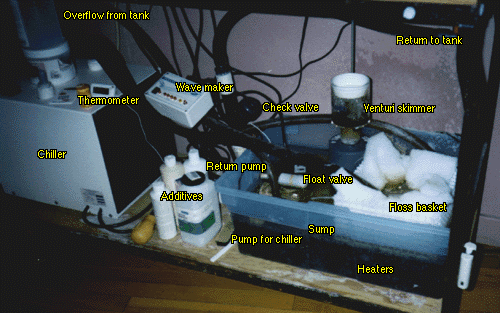The tank is a 70 gallon all glass tank, with a drilled bottom. It's 48" long, 18" high, and 18" deep. It sits on a wrought iron stand. I put a shelf of marine-grade plywood in the stand below the tank for the filtration.

The hole in the left side of the bottom of the tank is connected to a 2" PVC standpipe in the tank. The height of this controls the water level in the tank. The top of the standpipe has a plastic mesh on it to keep snails from going down the pipe and getting stuck in the plumbing (yes, it's happened). Below the tank there's a 1" PVC ball valve, and then 1" flexible plastic tubing down to the sump. The sump is a 10 gallon plastic storage container which normally has about 5 gallons of water in it. The water enters the sump into a basket of plastic "eggcrate", lined with course polyester fiber. This is the only mechanical filtration in the system.
The return from the sump is through a hole drilled in the side. This goes through 1" PVC pipe to a Rainbow Lifeguard QuietOne pump. The output of the pump goes through a check-valve, then 1" flexible tubing, a 1" PVC ball valve, and through the other hole in the bottom of the tank. Inside the tank this goes into a spray bar across the back bottom of the tank which sprays towards the front under the eggcrate.
Sitting in the sump is the protein skimmer. I'm currently using an Oceanic #4 skimmer, which is a venturi skimmer. Also sitting in the sump is an AquaClear 801 power head, connected to 1/2" flexible tubing which goes in the chiller. I've got a UMI 1/4 horse power chiller, with heater control thermostat. The output of the chiller goes back into the sump. Also in the sump, are two Ebo Jager 150 watt heaters, connected to the thermostat output of the chiller.
Also in the sump is a float valve. This is connected to the output line from my reverse osmosis filter. This makeup water for evaporation is automatically added to the tank as it is needed. While this is somewhat dangerous, since the R/O filter only generates about a gallon an hour, it can't put too much water on the floor if something goes wrong, can it?
Inside the tank, suction cupped to the back glass, are three powerheads to create more current. These are hooked up to a wavemaker that randomly turns them on and off once a minute. The top of the water is always in motion, and there are few if any still places in the tank.
The lighting is a CoraLife one-piece unit which contains two 175 watt metal halide fixtures and two 40 watt 48" florescent fixtures. The metal halide bulbs are Venture 5500K bulbs. The florescents are Phillips actinic/03. The fixture sits directly on the top edge of the tank, so that the florescents are about 6 inches above the water, and the MHs are about 4 inches above the water.



No comments:
Post a Comment